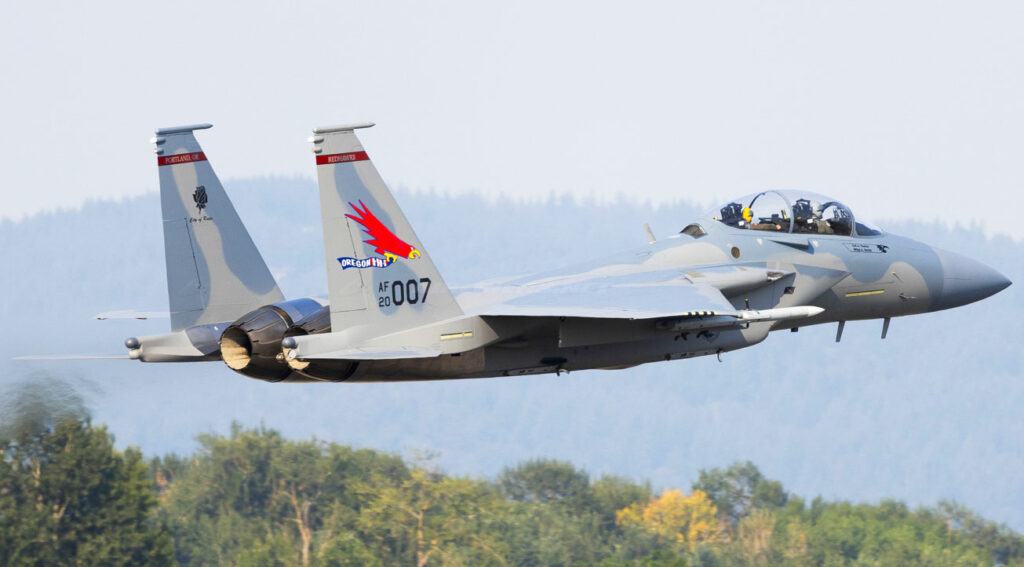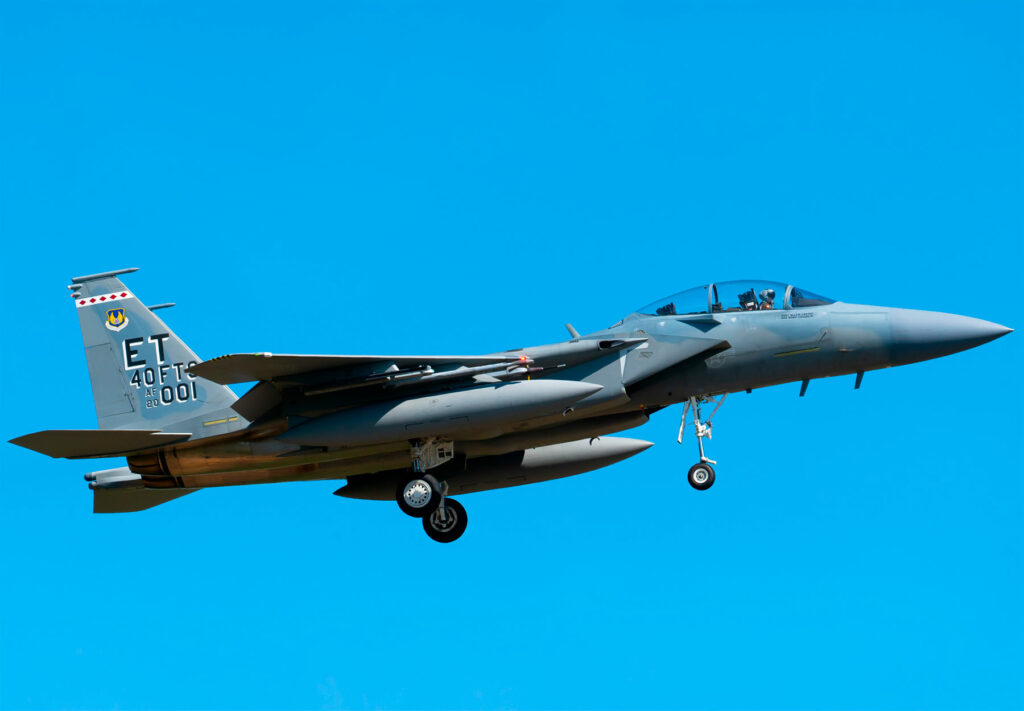The Boeing F-15EX Eagle II is an advanced multirole fighter jet, featuring modern avionics, increased payload capacity, and enhanced survivability systems.
The Boeing F-15EX Eagle II is a modernized iteration of the F-15 platform, designed to perform air superiority and strike missions. Equipped with advanced avionics, including the AN/APG-82(V)1 Active Electronically Scanned Array (AESA) radar, and powered by two General Electric F110-GE-129 engines, each producing 29,000 pounds (13,154 kg) of thrust, the F-15EX achieves speeds exceeding Mach 2.5. It features a digital fly-by-wire flight control system and the Eagle Passive/Active Warning and Survivability System (EPAWSS) for enhanced electronic warfare capabilities. The aircraft can carry a weapons payload of up to 29,500 pounds (13,381 kg) across 12 external hardpoints, accommodating a mix of air-to-air and air-to-ground munitions. The F-15EX’s advanced systems and increased payload capacity make it a formidable asset in modern combat scenarios.
History of the Development of the Boeing F-15EX Eagle II
In the late 2010s, the United States Air Force (USAF) faced the challenge of an aging fleet of F-15C/D aircraft, many of which were approaching the end of their service lives. Concurrently, delays in the F-35 Lightning II program and the limited number of F-22 Raptors underscored the need for a reliable and advanced multirole fighter to maintain air superiority and fulfill strike missions.
To address this capability gap, the USAF initiated the F-15EX program, aiming to leverage the existing F-15 airframe while incorporating modern technologies to enhance performance and survivability. Boeing, the manufacturer of the F-15, proposed the F-15EX as a cost-effective solution that would capitalize on the established production line and infrastructure.
The F-15EX is based on the F-15 Advanced Eagle family, specifically the F-15QA variant developed for the Qatar Emiri Air Force. This lineage provided a foundation of advanced features, including updated avionics, a digital fly-by-wire system, and increased payload capacity.
In 2018, the USAF and Boeing formalized plans for the F-15EX, with the objective of replacing the aging F-15C/D fleet and supplementing existing air combat capabilities. The program emphasized rapid integration of advanced systems and minimized developmental risks by utilizing a proven airframe.
The first F-15EX conducted its maiden flight on February 2, 2021, demonstrating the aircraft’s capabilities and validating its design enhancements. Following successful testing, the USAF took delivery of the initial F-15EX in March 2021, marking the beginning of a planned acquisition of at least 144 aircraft to replace the older F-15 models.
The F-15EX was officially named “Eagle II” during a ceremony at Eglin Air Force Base in April 2021, signifying its role as the latest evolution of the storied F-15 lineage. The aircraft’s development reflects a strategic decision to balance the introduction of fifth-generation fighters with the modernization of proven fourth-generation platforms, ensuring a robust and flexible fighter fleet capable of addressing diverse threats in an evolving global security environment.

Design of the Boeing F-15EX Eagle II
The Boeing F-15EX Eagle II retains the classic design elements of the F-15 series while incorporating significant advancements to meet modern combat requirements.
Airframe and Structure:
The F-15EX features a twin-engine, twin-tail configuration with a high-mounted swept wing design. The airframe is constructed primarily of aluminum alloys, with titanium and composite materials used in critical areas to enhance strength and reduce weight. The aircraft’s dimensions include a length of 63.8 feet (19.45 meters), a wingspan of 42.8 feet (13.05 meters), and a height of 18.5 feet (5.63 meters). The wing area measures 608 square feet (56.5 square meters), providing excellent lift and maneuverability.
Avionics and Systems:
A key advancement in the F-15EX is its digital fly-by-wire flight control system, replacing the mechanical controls of earlier models. This system enhances aircraft handling, stability, and allows for future software upgrades. The cockpit is equipped with advanced avionics, including large-area multifunction displays (LAD), a wide-angle head-up display (HUD), and a Joint Helmet-Mounted Cueing System (JHMCS) for superior situational awareness.
Radar and Sensors:
The F-15EX features the AN/APG-82(V)1 AESA radar, which provides enhanced detection, tracking, and target engagement capabilities. This radar can simultaneously track multiple targets in air and ground domains. Additionally, the aircraft is equipped with the Eagle Passive/Active Warning and Survivability System (EPAWSS), which delivers advanced electronic warfare capabilities, including threat detection and countermeasures.
Weapons Payload:
The F-15EX is designed to carry up to 29,500 pounds (13,381 kg) of weapons, including 12 external hardpoints and the ability to mount future weapons systems. Its weapons payload includes air-to-air missiles like the AIM-120 AMRAAM and AIM-9X Sidewinder, as well as air-to-ground munitions such as the Joint Direct Attack Munition (JDAM), Small Diameter Bomb (SDB), and AGM-88 HARM missiles. This versatility ensures compatibility with existing and emerging weapons.
Strengths and Limitations:
The F-15EX offers unmatched payload capacity and advanced systems while retaining the speed and agility characteristic of the F--15 series. Its strengths include compatibility with existing infrastructure and reduced lifecycle costs due to its design based on proven platforms. However, as a fourth-generation-plus aircraft, the F-15EX lacks the stealth features of fifth-generation fighters, such as the F-35, which may limit its survivability in highly contested environments.
Performance of the Boeing F-15EX Eagle II
The performance of the F-15EX is a key factor in its role as a modern multirole fighter, ensuring both versatility and operational superiority.
Engines and Power:
The aircraft is powered by two General Electric F110-GE-129 turbofan engines, each capable of producing 29,000 pounds (13,154 kg) of thrust. This dual-engine configuration ensures high performance across all flight regimes and provides redundancy for increased reliability.
Speed and Altitude:
The F-15EX can reach a maximum speed of Mach 2.5 (1,900 mph or 3,058 km/h) at high altitudes, making it one of the fastest combat aircraft in operation. Its operational ceiling is approximately 60,000 feet (18,288 meters), enabling it to conduct high-altitude missions, including air superiority engagements and reconnaissance.
Range and Payload:
The combat range of the F-15EX is estimated to be 1,200 nautical miles (2,222 km) without aerial refueling, with an extended range capability provided by conformal fuel tanks (CFTs). These tanks increase fuel capacity without occupying external hardpoints, preserving its weapon-carrying capabilities.
With a weapons payload of 29,500 pounds (13,381 kg), the F-15EX is unmatched in its ability to carry a wide range of armaments. This capacity allows it to perform simultaneous air-to-air and air-to-ground missions, increasing its tactical flexibility.
Maneuverability:
Despite its large size and payload capacity, the F-15EX maintains impressive maneuverability. Its high thrust-to-weight ratio and advanced flight control systems enable tight turns and rapid response to combat scenarios.
Comparison to Competitors:
Compared to the F-35 Lightning II, the F-15EX offers greater speed, range, and payload capacity, but lacks stealth and advanced networking capabilities. Against other fourth-generation fighters, such as the Eurofighter Typhoon and Dassault Rafale, the F-15EX excels in payload and range but may be outmatched in agility in some scenarios.
Variants of the Boeing F-15EX Eagle II
The F-15EX program primarily focuses on a single production variant; however, discussions about potential future configurations for specialized roles exist.
1. Baseline F-15EX:
This is the standard production variant intended for the USAF. It includes the full suite of avionics, EPAWSS, and AESA radar, along with the ability to integrate emerging weapons systems.
2. Future Variants:
While no formalized variants have been developed, Boeing has indicated the F-15EX can be adapted for specific roles, such as electronic warfare or reconnaissance, through modular upgrades and mission-specific payloads.
3. Export Models:
The F-15EX could see customized variants for international customers. For example, nations operating legacy F-15s may seek upgrades tailored to their defense needs, integrating unique systems or weapons.

Military Use and Combat of the Boeing F-15EX Eagle II
The F-15EX Eagle II has been designed to serve as a multirole platform, excelling in air superiority, strike missions, and electronic warfare. Its large payload and advanced systems ensure it is well-suited for modern combat scenarios.
Air Superiority:
The F-15EX is a dominant force in air-to-air combat, equipped with advanced missiles such as the AIM-120 AMRAAM and AIM-9X Sidewinder. These weapons enable it to engage targets at both long and short ranges. Its AESA radar ensures superior target detection and tracking, while EPAWSS provides protection against enemy radar and missile threats.
Strike Missions:
For air-to-ground operations, the F-15EX can carry precision-guided munitions such as JDAMs, SDBs, and AGM-158 JASSM missiles. This capability allows it to engage hardened targets, command centers, and other strategic assets with pinpoint accuracy.
Electronic Warfare:
The EPAWSS system makes the F-15EX capable of performing electronic warfare missions, including jamming enemy radars and disrupting communications. This system enhances survivability and provides support for other aircraft in the formation.
Combat Scenarios:
While the F-15EX has yet to see combat as of early 2025, its predecessors in the F-15 family have demonstrated outstanding performance in various conflicts. The F-15EX builds on this legacy with enhanced capabilities designed for the modern battlefield.
International Use:
The F-15EX is currently operated by the United States Air Force, with discussions ongoing for potential sales to allied nations, particularly those already operating F-15 variants. Its interoperability with existing infrastructure and compatibility with a wide range of munitions make it an attractive option for export.
Competing Aircraft in Combat Roles:
In contested environments, the F-15EX competes with fifth-generation aircraft like the F-35 and Su-57, as well as advanced fourth-generation platforms such as the Rafale and Typhoon. While the F-15EX lacks stealth, its payload capacity and survivability systems provide a significant advantage in certain mission profiles.
The Boeing F-15EX Eagle II is a modernized multirole fighter designed to bridge the gap between fourth and fifth-generation aircraft. Its advanced avionics, unmatched payload capacity, and compatibility with emerging weapon systems position it as a critical asset for the USAF. While it faces challenges in highly contested environments due to the lack of stealth, its versatility and cost-effectiveness ensure its relevance in diverse combat scenarios. As a continuation of the F-15 lineage, the Eagle II provides a reliable and capable platform for modern air operations.
Back to the Fighter Jet section.